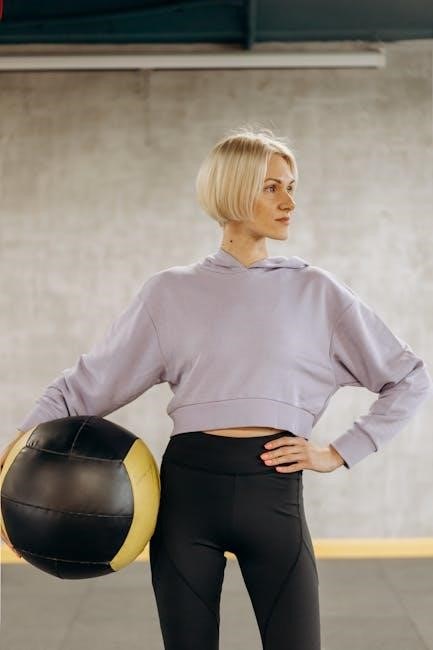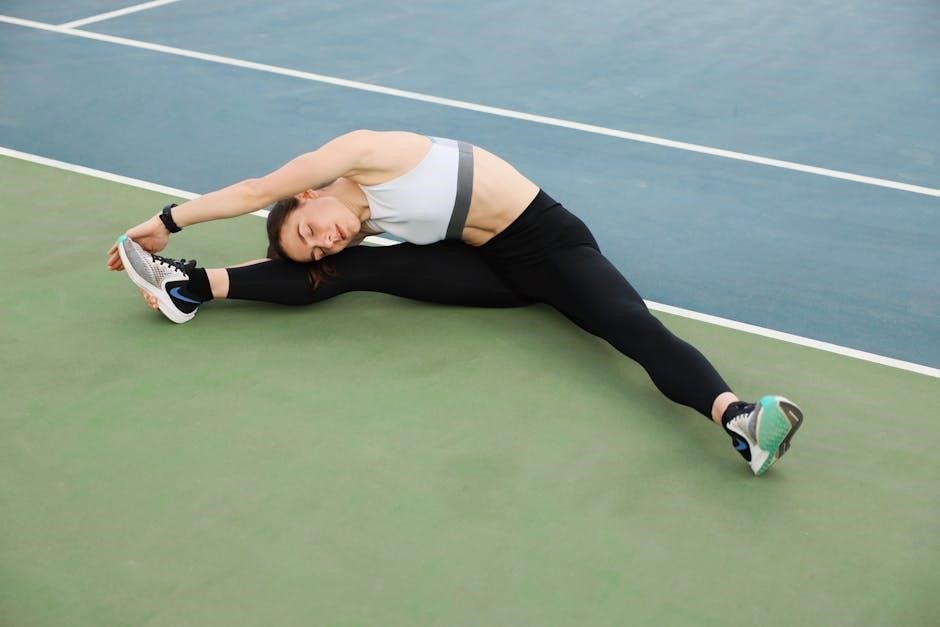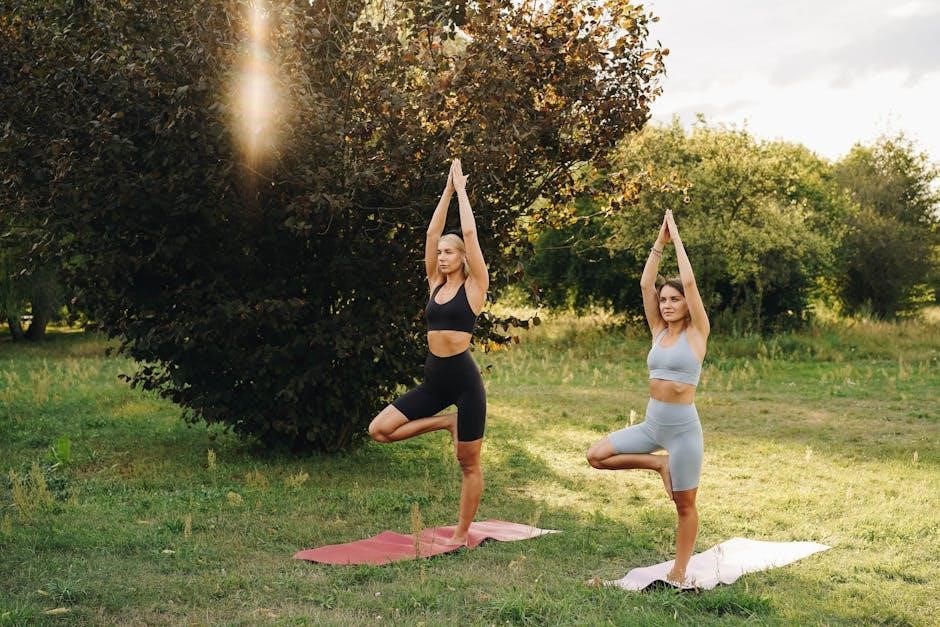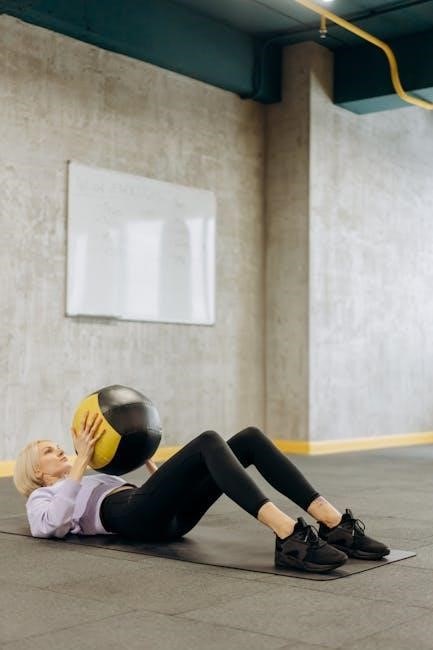scapular stabilization exercises pdf
Grab our FREE scapular stabilization exercises PDF! Say goodbye to shoulder pain and hello to better posture. Download now and feel the difference!
Scapular Stabilization Exercises PDF: A Comprehensive Guide
This comprehensive guide delves into scapular stabilization exercises. These exercises strengthen shoulder girdle muscles‚ restoring normal scapular motion and correcting dyskinesis. Proper execution ensures effective energy transfer through the kinetic chain‚ crucial for overall rehabilitation and athletic performance.
Scapular stabilization exercises are a cornerstone of rehabilitation and injury prevention programs‚ focusing on strengthening the muscles surrounding the shoulder blade. These exercises aim to restore proper scapular mechanics‚ which is crucial for optimal shoulder function and overall upper body movement. The scapula‚ or shoulder blade‚ plays a vital role in shoulder joint stability and movement‚ acting as a base for arm elevation and rotation.
Dysfunctional scapular movement‚ known as scapular dyskinesis‚ can lead to various shoulder problems‚ including impingement‚ rotator cuff tears‚ and instability. Therefore‚ incorporating scapular stabilization exercises into a routine helps improve posture‚ reduce pain‚ and enhance athletic performance. This introduction highlights the importance of understanding and implementing these exercises effectively‚ laying the groundwork for a healthier and more functional shoulder complex. Targeted exercises improve the strength and control of the muscles that support the scapula.
Understanding the Importance of Scapular Stability
Scapular stability is paramount for optimal shoulder function and overall upper body health. The scapula serves as the foundation upon which the shoulder joint operates‚ providing a stable base for arm movements. When the scapula is unstable‚ it can lead to altered shoulder mechanics‚ increasing the risk of injury and limiting performance. Proper scapular positioning and movement are essential for activities ranging from everyday tasks to high-level athletic endeavors.
Scapular stability ensures the efficient transfer of force from the body to the arm‚ allowing for powerful and coordinated movements. Without adequate stability‚ the surrounding muscles must compensate‚ leading to fatigue‚ pain‚ and potential injury. Furthermore‚ scapular stability contributes to proper posture‚ reducing strain on the neck and upper back. Incorporating targeted exercises that enhance scapular control and strength is crucial for maintaining healthy shoulder function‚ preventing injuries‚ and optimizing athletic performance. Achieving scapular stability is integral to a well-functioning upper body kinetic chain.
Common Causes of Scapular Dyskinesis
Scapular dyskinesis‚ or altered scapular movement‚ arises from a variety of factors‚ often involving muscle imbalances and neurological issues. Weakness or inhibition of key scapular stabilizers‚ such as the serratus anterior‚ trapezius (especially the lower fibers)‚ and rhomboids‚ is a frequent culprit. These muscles work in concert to control scapular rotation‚ protraction‚ retraction‚ and elevation. When one or more of these muscles are compromised‚ the scapula may move abnormally.
Poor posture‚ particularly prolonged slouching or rounded shoulders‚ can also contribute to dyskinesis by placing excessive strain on certain muscles and weakening others. Nerve injuries‚ such as long thoracic nerve damage affecting the serratus anterior‚ can lead to significant scapular winging and impaired function. Additionally‚ shoulder impingement‚ rotator cuff tears‚ and other shoulder pathologies can cause pain and altered movement patterns‚ resulting in secondary scapular dyskinesis. Addressing these underlying causes is crucial for effective management and rehabilitation of scapular dyskinesis.

Scapular Stabilization Exercises
These exercises aim to strengthen the muscles surrounding the scapula‚ promoting proper movement and stability. Consistent practice‚ focusing on form‚ is vital for optimal results and injury prevention. They help correct dyskinesis.
Shoulder Shrugs
Shoulder shrugs are a simple yet effective exercise for targeting the upper trapezius muscles‚ which play a crucial role in scapular elevation and overall shoulder stability. To perform a shoulder shrug correctly‚ begin by standing or sitting with your arms relaxed at your sides. Ensure your posture is upright‚ and your core is engaged to maintain stability throughout the movement.
Slowly elevate your shoulders towards your ears as high as comfortably possible. Focus on using your trapezius muscles to lift the weight‚ avoiding any jerky or sudden movements. Hold the contracted position for a brief moment‚ feeling the tension in your upper back and neck.
Gradually lower your shoulders back to the starting position‚ maintaining control throughout the descent. Avoid simply dropping your shoulders; instead‚ focus on a smooth and controlled return. Repeat this movement for the recommended number of repetitions‚ typically 10-15 repetitions per set. Remember to breathe rhythmically throughout the exercise‚ inhaling as you lower your shoulders and exhaling as you shrug them upwards.

Shoulder Rolls
Shoulder rolls are a dynamic exercise that promotes scapular mobility and improves circulation in the shoulder region. This exercise can help alleviate stiffness and tension in the upper back and neck‚ contributing to enhanced scapular stability and overall shoulder health. To perform shoulder rolls effectively‚ begin by standing or sitting with a relaxed posture.
Gently roll your shoulders forward in a circular motion‚ focusing on engaging the muscles around your shoulder blades. As you roll forward‚ bring your shoulders up towards your ears‚ then forward‚ and finally down and back. Maintain a smooth and controlled movement throughout the exercise‚ avoiding any jerky or abrupt motions.
After completing several repetitions in the forward direction‚ reverse the motion and roll your shoulders backward. Again‚ focus on engaging the scapular muscles as you roll‚ bringing your shoulders up towards your ears‚ then backward‚ and finally down and forward. Continue alternating between forward and backward shoulder rolls for the recommended duration‚ typically 1-2 minutes. Remember to breathe deeply and rhythmically throughout the exercise‚ allowing for increased relaxation and improved circulation.
Scapular Retractions (Squeezes)
Scapular retractions‚ often called scapular squeezes‚ are a fundamental exercise for improving scapular stability and posture. This exercise targets the muscles that draw the shoulder blades together‚ primarily the rhomboids and trapezius. Strengthening these muscles helps counteract rounded shoulders and promotes better alignment of the upper back. To perform scapular retractions effectively‚ start by sitting or standing tall with your shoulders relaxed.
Imagine you are trying to squeeze a pencil between your shoulder blades. Gently pull your shoulder blades together‚ focusing on engaging the muscles in your upper back. Hold this squeezed position for a few seconds‚ feeling the contraction in your rhomboids and trapezius.
Avoid shrugging your shoulders up towards your ears or arching your back during the exercise. Maintain a neutral spine and focus solely on drawing your shoulder blades together. After holding the squeeze for a few seconds‚ slowly release the tension and allow your shoulder blades to return to their starting position. Repeat this exercise for the recommended number of repetitions‚ typically 10-15‚ ensuring proper form and controlled movements throughout. Consistent practice of scapular retractions will contribute to improved posture‚ reduced upper back pain‚ and enhanced scapular stability.

Prone Scapular Exercises
Prone scapular exercises are performed lying face down‚ offering a unique advantage for strengthening the muscles surrounding the shoulder blades. This position minimizes the influence of gravity‚ allowing for targeted activation of the scapular stabilizers. These exercises are particularly effective for individuals with shoulder instability‚ rotator cuff issues‚ or those seeking to improve posture and upper back strength.
By lying prone‚ you can isolate the scapular muscles and reduce the tendency to compensate with other muscle groups. Several variations of prone scapular exercises exist‚ each focusing on different movement patterns and muscle activation. Common examples include prone scapular retractions‚ prone horizontal abduction‚ and prone rows.
These exercises involve specific arm movements while maintaining the prone position‚ emphasizing controlled and precise scapular motion. It’s crucial to maintain proper form throughout each exercise‚ focusing on squeezing the shoulder blades together or lifting the arms while keeping the scapula stable. Start with a low number of repetitions and gradually increase as your strength improves. Prone scapular exercises are a valuable addition to any scapular stabilization program‚ helping to enhance shoulder function‚ reduce pain‚ and improve overall upper body mechanics.
Prone Scapular Retraction
Prone scapular retraction is a fundamental exercise for strengthening the muscles responsible for pulling the shoulder blades together. This exercise is performed lying face down with your arms resting comfortably at your sides. The primary focus is on squeezing the shoulder blades together‚ mimicking the action of pinching something between them. It’s crucial to maintain a neutral neck position throughout the exercise‚ avoiding any unnecessary strain.
Begin by gently contracting the muscles between your shoulder blades‚ drawing them inward towards your spine. Hold this contracted position for a few seconds‚ feeling the muscles engage. Slowly release the contraction‚ allowing your shoulder blades to return to their starting position. Repeat this movement for a prescribed number of repetitions‚ focusing on controlled and precise movements.
Prone scapular retractions are particularly beneficial for improving posture‚ addressing rounded shoulders‚ and enhancing shoulder stability. This exercise helps to strengthen the rhomboids and trapezius muscles‚ which play a vital role in maintaining proper scapular alignment. Regular practice of prone scapular retractions can contribute to reduced shoulder pain‚ improved upper body function‚ and enhanced athletic performance. Remember to consult with a healthcare professional before starting any new exercise program‚ especially if you have any pre-existing shoulder conditions.
Prone Horizontal Abduction
Prone horizontal abduction is an effective exercise for strengthening the posterior shoulder muscles‚ particularly the rotator cuff and scapular stabilizers. To perform this exercise‚ lie face down on a flat surface with your arms extended out to the sides‚ forming a “T” shape with your body. Your palms should be facing down towards the floor.
Initiate the movement by gently lifting your arms off the floor‚ maintaining a slight bend in your elbows. Focus on squeezing your shoulder blades together as you raise your arms‚ engaging the muscles in your upper back. It’s important to avoid shrugging your shoulders towards your ears during the exercise. Hold the elevated position for a brief moment‚ feeling the contraction in your posterior shoulder muscles.
Slowly lower your arms back down to the starting position‚ maintaining control throughout the movement. Repeat this process for the desired number of repetitions. Prone horizontal abduction helps improve shoulder stability‚ posture‚ and overall upper body strength. It’s crucial to use proper form to prevent injury and maximize the benefits of the exercise. Consider consulting a physical therapist or certified trainer for guidance on proper technique and exercise progression. Remember to listen to your body and stop if you experience any pain.
Wall Slides
Wall slides are a fantastic exercise for improving scapular mobility‚ strengthening the muscles that control scapular movement‚ and promoting better posture. To begin‚ stand with your back against a wall‚ ensuring that your head‚ upper back‚ and buttocks are in contact with the surface. Position your feet a comfortable distance away from the wall‚ about shoulder-width apart.
Next‚ raise your arms to shoulder height‚ bending your elbows at a 90-degree angle‚ so that your upper arms are parallel to the floor and your forearms are pointing upwards. The backs of your hands and elbows should also be touching the wall. This is your starting position.
Slowly slide your arms up the wall‚ maintaining contact with the wall throughout the movement. As you slide your arms upwards‚ focus on squeezing your shoulder blades together and downwards‚ as if you were trying to pinch a pencil between them. Continue sliding your arms up as far as you can comfortably go‚ without losing contact with the wall or arching your lower back.
Once you reach the top of the movement‚ slowly slide your arms back down to the starting position‚ maintaining control and continuing to squeeze your shoulder blades together. Repeat this exercise for the desired number of repetitions. Wall slides are a great way to improve scapular stability and prevent shoulder pain.
Physioball Scapular Exercises
Physioball exercises add an element of instability‚ further engaging the scapular stabilizers. One effective exercise involves standing with your back against a wall and placing a physioball between your back and the wall. Position the ball at the level of your shoulder blades. Gently lean into the ball‚ ensuring it is stable and secure.
Next‚ perform small circular motions with your torso‚ using the ball to massage and mobilize your scapular region. Focus on controlled movements and maintain good posture throughout the exercise. You can also perform scapular retractions by squeezing your shoulder blades together while maintaining contact with the ball.
Another variation involves placing your hand on the physioball against a wall. Bring your shoulders back and down‚ then slowly roll your hand side to side over the ball‚ maintaining proper shoulder position. These physioball exercises enhance proprioception‚ improve scapular control‚ and strengthen the surrounding muscles‚ leading to improved shoulder stability and reduced risk of injury. Remember to perform these exercises with caution and proper form to avoid any discomfort.

Additional Considerations
Beyond the exercises‚ remember proper form is key to prevent injury. Listen to your body and seek professional help if experiencing pain. Consistency and patience are vital for achieving optimal scapular stability and function.
Importance of Proper Form and Technique
Achieving optimal results from scapular stabilization exercises hinges significantly on maintaining proper form and technique. Incorrect execution can not only diminish the effectiveness of the exercises but also potentially lead to further injury or exacerbate existing conditions. Focus on controlled movements‚ ensuring that the targeted muscles are actively engaged throughout each repetition.
Pay close attention to the positioning of your body‚ particularly the alignment of your spine and shoulders. Avoid compensating with other muscle groups‚ such as your neck or lower back‚ as this can lead to strain and discomfort. If you are unsure about the correct form‚ seek guidance from a physical therapist or qualified healthcare professional.
They can provide personalized instruction and feedback‚ helping you to master the proper technique and maximize the benefits of these exercises while minimizing the risk of injury. Remember‚ quality over quantity is paramount; performing fewer repetitions with correct form is far more beneficial than rushing through numerous repetitions with poor technique. Prioritize precision and control in every movement.
When to Seek Professional Help
While scapular stabilization exercises can be highly beneficial‚ it’s crucial to recognize when professional help is necessary. If you experience persistent pain‚ especially sharp or shooting pain‚ during or after performing these exercises‚ discontinue immediately and consult a healthcare professional. Similarly‚ if you notice a significant decrease in your range of motion or strength‚ seek expert advice.
Individuals with pre-existing shoulder conditions‚ such as rotator cuff tears‚ impingement syndrome‚ or instability‚ should consult with a physical therapist or orthopedic specialist before starting any new exercise program. A professional can assess your specific condition‚ identify any underlying issues‚ and develop a tailored treatment plan that addresses your individual needs.
Moreover‚ if you’ve been performing scapular stabilization exercises consistently for several weeks without experiencing any noticeable improvement‚ it may be time to seek professional guidance. A qualified healthcare provider can evaluate your technique‚ modify your exercise program‚ and explore other potential treatment options to help you achieve your desired outcomes. Don’t hesitate to seek expert advice.

